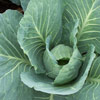Cruciferous Crops
December 1, 2006
Only the hardiest fruits and vegetables can survive the freezing temperatures that inland California farms experienced several nights this week. Frosts and freezes can spell the end of tomatoes, peppers, berries, some lettuces, and other fragile crops. Lucky for us, one of the most cold-tolerant plant families encompasses more vegetables than any other.
Brassicaceae has made a substantial contribution to humans’ foods choices: the enormous cabbage family includes turnips, kohlrabi, Brussels sprouts, broccoli, cauliflower, rapini, romanesco, mustard seed, mustard greens, collards, kale, bok choy, canola, rutabaga, radish, watercress, and arugula, among others. Brassicas are also called cruciferous vegetables (from the Latin crux, which means cross) because they bear
flowers with four petals in the shape of a cross. The common ancestor of these plants probably originated in  Northern Europe where (headless) cabbages were first cultivated thousands of years ago. Subsequently, the crop spread around Europe and Asia where it malleably transformed into the many cruciferous crops we know today. Vegetables like broccoli, romanesco, and cauliflower were selected for large flowering heads; mustard greens, cabbage, collards, and bok choy for big greens; turnips, radishes, and kohlrabi for bulbous stems and roots. Just a few species comprise most of the brassicas we regularly eat. Broccoli, cauliflower, cabbage, kale, collard
Northern Europe where (headless) cabbages were first cultivated thousands of years ago. Subsequently, the crop spread around Europe and Asia where it malleably transformed into the many cruciferous crops we know today. Vegetables like broccoli, romanesco, and cauliflower were selected for large flowering heads; mustard greens, cabbage, collards, and bok choy for big greens; turnips, radishes, and kohlrabi for bulbous stems and roots. Just a few species comprise most of the brassicas we regularly eat. Broccoli, cauliflower, cabbage, kale, collard  greens, and kohlrabi, different as they look, are all cultivar groups of the species Brassica oleracea. Turnip, rapini, bok choy and tatsoi all belong to the species Brassica rapa.
greens, and kohlrabi, different as they look, are all cultivar groups of the species Brassica oleracea. Turnip, rapini, bok choy and tatsoi all belong to the species Brassica rapa.
As farmers will attest, humans aren’t the only brassica-loving species. For growers, the vegetables are both a blessing (what else will survive winter frosts?), and a challenge. One of the most virulent brassica pests is the aphid, which quickly reproduces and sucks the fluids out of the  crop, stunting growth and sometimes killing plants. Even if the insects don’t do extensive physical damage, they may still render the harvest unmarketable: aphids (as many of us have experienced) nestle within the leaves of a head of cabbage or amid the broccoli florets and are difficult to remove. To deal with aphids, farmers, like many gardeners, use soap sprays and release beneficial predators like ladybugs.
crop, stunting growth and sometimes killing plants. Even if the insects don’t do extensive physical damage, they may still render the harvest unmarketable: aphids (as many of us have experienced) nestle within the leaves of a head of cabbage or amid the broccoli florets and are difficult to remove. To deal with aphids, farmers, like many gardeners, use soap sprays and release beneficial predators like ladybugs.

Nigel Walker of Eatwell Farm says that caterpillars are his biggest brassica pest, but the farm has only sprayed the organic insecticide they use to combat the pest once this year. Recently, Eatwell Farm’s pest problems have declined considerably, which Nigel attributes this to the maturity of the farm; it is reaching, he says, a sort of ecological balance. His goal is not to eliminate pest populations completely, but to keep them in check so they don’t do any serious economic damage. If the farm provides habitat for caterpillar predators, like kestrels, and aphid predators, like ladybugs, the farm saves money on expensive insecticides and harvests a hearty crop of crucifers.
Besides having a reputation for being a healthful, cancer-fighting class of vegetables, brassicas are known for the eggy aroma they exude when cooked. These two famous features are actually related: the sulfur-containing compounds called glucosinolates that give the brassicas their pungent smell also give them some of their nutritive qualities. Brassicas contain lots of vitamin A and C, too.
Topics: Vegetables
